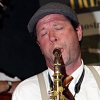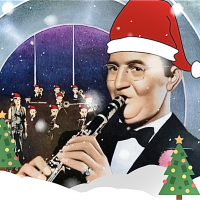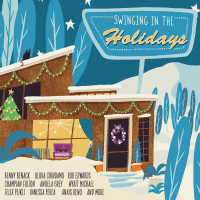Home » Jazz Musicians » Louis Jordan
Louis Jordan
At the height of his career, in the 1940s, bandleader and alto saxophonist Louis Jordan scored 18 Number One hit records. Jordan exhibited a brilliant sense of showmanship that brought audiences first-rate entertainment without any loss of musical integrity. He performed songs that appealed to millions of black and white listeners. Able to communicate between these two audiences, Jordan emerged as one of the first successful crossover artists of American popular music. Born on July 8, 1908, in Brinkley, Arkansas, Jordan was the son of Jim Jordan, a bandleader and music teacher. Under the tutelage of his father, Jordan began studying clarinet at age seven, then saxophone. His first professional engagement was with Fat Chappelle's Rabbit Foot Minstrels, playing clarinet and dancing throughout the South. At Arkansas Baptist College in Little Rock, Jordan majored in music. After school he played local dates with Jimmy Pryor's Imperial Serenaders. Moving to Philadelphia in 1930, Jordan worked with trumpeter Charlie Gaines's orchestra and tuba player Jim Winters's band. Two years later, Jordan traveled to New York with Gaines's group, where he took part in a recording session with pianist Clarence Williams's band. In New York he briefly worked with the bands of Kaiser Marshall and drummer Joe Marshall. His most important job, though, came in 1936 when he joined drummer Chick Webb's orchestra, a 13-piece ensemble that featured singer Ella Fitzgerald; Webb hired Jordan as a singer, sideman, and announcer. In 1937 Jordan recorded his first vocal with Webb's band, a song titled "Gee, But You're Swell." During his stint with Webb Jordan developed his skills as a frontman. In the summer of 1938, Jordan left Webb's orchestra to form his own, nine-piece, band; although Jordan enjoyed performing as part of large jazz ensembles, he embarked on a career as a bandleader and more general entertainer. Billing himself as "Bert Williams," Jordan played shows at the Elk's Rendezvous at 44 Lenox Avenue, in Harlem. His long residency at the club eventually prompted him to name his group the Elk's Rendezvous Band.. In 1939, this group recorded several sides for the Decca label; one was “Honey in the Bee Ball.” Changing the name of his band to the Tympany Five, Jordan reduced the size of the unit to six members (later it would number seven or eight). The real turning point in Jordan's career came when he performed at a small "beer joint" called the Fox Head Tavern in Cedar Rapids, Iowa.
Read moreTags
Bebop’s Twin: Rhythm and Blues (1939 - 1951)

by Russell Perry
Some of the same forces that launched Bebop as a break from Big Band Swing, also fueled the birth of Rhythm and Blues—the rise of independent labels in the wake of the recording ban of 1942— 1944, the economic infeasibility of touring with 16-member orchestras, the decline of dance halls in the aftermath of the war, and the rise of juke boxes and radio as primary entertainment media. Bebop and R&B also shared the big bands as a common pool ...
Continue ReadingDanny Bacher All-Star Band Returns To The Metropolitan Room On August 4 & 25 - Celebrating Louis Armstrong, Louis Prima & Louis Jordan!

Source:
Scott Thompson Public Relations
Danny Bacher returns to the Metropolitan Room on August 4 & 25 with his All-Star Band Celebrating Upcoming Debut CD Swing That Music! Danny Bacher Sings and Plays Louis Armstrong, Louis Prima and Louis Jordan" Advance EP features: Warren Vache, Bill Goodwin, Ray Drummond, Howard Alden, Houston Person and Cyrille Aimée Danny Bacher and his All-Star Band are back by popular demand at Manhattan's Metropolitan Room with special guest vocalists both August 4 and August 25! Make your reservations now! ...
read more
Black Rep to Open Louis Jordan Musical on Wednesday, March 24

Source:
St. Louis Jazz Notes by Dean Minderman
Having just closed its production of Yesterdays: An Evening With Billie Holiday with singer Vanessa Rubin, the Black Rep has another musical coming up that also may appeal to St. Louis jazz fans. The company's staging of Five Guys Named Moe, which is based on the music of saxophonist and singer Louis Jordan, opens next Wednesday, March 24 and continues through Sunday, April 25 at the Grandel Theatre.Combining elements drawn from big band swing and rhythm & blues ...
read more




















































